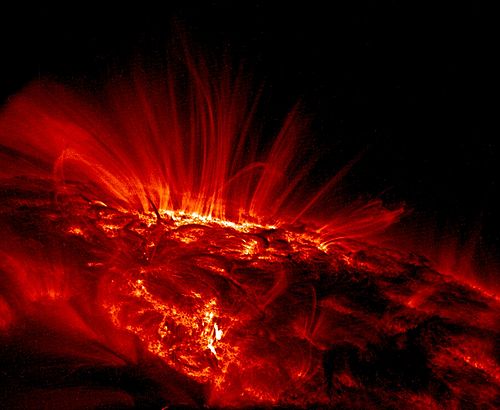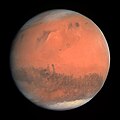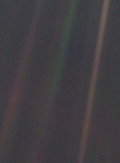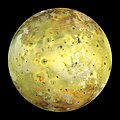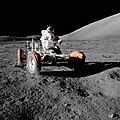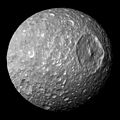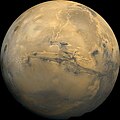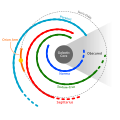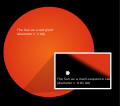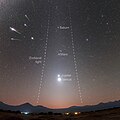Portal:Solar System
Appearance
The Solar System Portal

The fusion of hydrogen into helium at its core, releasing this energy from its outer photosphere. Astronomers classify it as a G-type main-sequence star.
The largest objects that orbit the Sun are the eight
giant planets
are mainly composed of fluids and as such do not have a fixed surface. Over 99.86% of the Solar System's mass is located within the Sun, and nearly 90% of the rest forms Jupiter and Saturn.
There is a strong consensus among astronomers that the Solar System has at least nine
centaurs, meteoroids, and interplanetary dust clouds. Some of these bodies are in the asteroid belt (between Mars's and Jupiter's orbit) and the Kuiper belt (just outside Neptune's orbit). Six planets, seven dwarf planets, and other bodies have orbiting natural satellites
, which are commonly called 'moons'.
The Solar System is constantly flooded by outflowing
long-period comets, extending to a radius of 2,000–200,000 AU. The closest star to the Solar System, Proxima Centauri, is 4.25 light-years (269,000 AU) away. Both stars belong to the Milky Way galaxy. (Full article...
)
Selected article –
creatures which inhabited Mount Ida in Greek mythology. Data returned from the flyby pointed to S-type asteroids as the source for the ordinary chondrite meteorites, the most common type found on the Earth's surface. (Full article...
)
Selected picture
-
total eclipse in human history, although some areas offered impaired visibility due to adverse weather conditions. The path of the Moon's shadow began in the Atlantic Ocean, before traversing Cornwall, northern France, southern Germany, Austria, Hungary and northern Serbia. Its maximum was in Romania, and it continued across the Black Sea, Turkey, Iran, southern Pakistan and India.
-
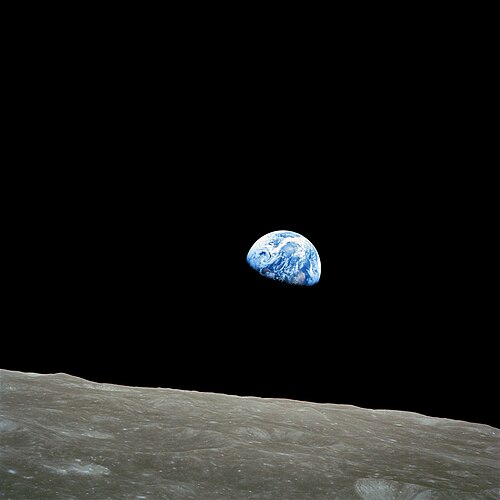
Earthrise, as seen by Apollo 8 Credit: William AndersEarthrise, the first occasion in which humans saw the Earth seemingly rising above the surface of the Moon, taken during the Apollo 8 mission on December 24, 1968. This view was seen by the crew at the beginning of its fourth orbit around the Moon, although the first photograph taken was in black-and-white. Note that the Earth is in shadow here. A photo of a fully lit Earth would not be taken until the Apollo 17 mission. -
A TRACE image of sunspots on the surface, or photosphere, of the Sun from September 2002, is taken in the far ultraviolet on a relatively quiet day for solar activity. However, the image still shows a large sunspot group visible as a bright area near the horizon. Although sunspots are relatively cool regions on the surface of the Sun, the bright glowing gas flowing around the sunspots have a temperature of over one million °C (1.8 million °F). The high temperatures are thought to be related to the rapidly changing magnetic field loops that channel solar plasma.
-
Jack Schmitt — all of whom took photographic images during the mission. Apollo 17 passed over Africa during daylight hours and Antarctica is also illuminated. The photograph was taken approximately five hours after the spacecraft's launch, while en route to the Moon. Apollo 17, notably, was the last manned lunar mission; no humans since have been at a range where taking a "whole-Earth" photograph such as "The Blue Marble" would be possible.rotation period and seasonal cycles are also similar to those of the Earth. Of all the planets in the Solar System other than Earth, Mars is the most likely to harbour liquid water and perhaps life. There are ongoing investigations assessing Mars's past potential for habitability, as well as the possibility of extant life. Future astrobiology missions are planned, including NASA's Mars 2020 rover and the European Space Agency (ESA)'s Rosalind Franklin rover. In November 2016, NASA reported finding a large amount of underground ice in the Utopia Planitia region of the planet. The volume of water detected has been estimated to be equivalent to the volume of water in Lake Superior. Mars has two moons, Phobos and Deimos, which are small and irregularly shaped.
This picture is a true-colour image of Mars, taken from a distance of about 240,000 kilometres (150,000 mi) by the OSIRIS instrument on ESA's Rosetta spacecraft, during its February 2007 flyby of the planet. The image was generated using OSIRIS's orange (red), green and blue filters.lens, resulting from the small angle between Earth and the Sun. Carl Sagan came up with the idea of turning the spacecraft around to take a composite image of the Solar System. Six years later, he reflected, "All of human history has happened on that tiny pixel, which is our only home."Cassini orbiter. Individual rings seen in this image include (in order, starting from most distant): E ring, Pallene ring (visible very faintly in an arc just below Saturn), G ring, Janus/Epimetheus ring (faint), F ring (narrow brightest feature), Main rings (A,B,C), and D ring (bluish, nearest Saturn). Interior to the G ring and above the brighter main rings is the pale dot of Earth.A true-color image of Io, one of the moons of Jupiter, taken by the Galileo spacecraft. The dark spot just left of the center is the erupting volcano Prometheus. The whitish plains on either side of it are coated with volcanically deposited sulfur dioxide frost, whereas the yellower regions contain a higher proportion of sulfur.Image credit: United States Geological SurveyA composite image of Olympus Mons on Mars, the tallest known volcano and mountain in the Solar System. This image was created from black-and-white imagery from the USGS's Mars Global Digital Image Mosaic and color imagery acquired from the 1978 visit of Viking 1.Eugene Cernan makes a short test drive of the lunar rover (officially, Lunar Roving Vehicle or LRV) during the early part of the first Apollo 17 extravehicular activity. The LRV was only used in the last three Apollo missions, but it performed without any major problems and allowed the astronauts to cover far more ground than in previous missions. All three LRVs were abandoned on the Moon.These images are composites of the complete radar image collection obtained by the Magellan mission. The Magellan spacecraft was launched aboard Space Shuttle Atlantis in May 1989 and began mapping the surface of Venus in September 1990. The spacecraft continued to orbit Venus for four years, returning high-resolution images, altimetry, thermal emissions and gravity maps of 98 percent of the surface. Magellan spacecraft operations ended on October 12, 1994, when the radio contact was lost with the spacecraft during its controlled descent into the deeper portions of the Venusian atmosphere.apparent retrograde motion of Mars in 2003 as seen from Earth. All the true planets appear to periodically switch direction as they cross the sky. Because Earth completes its orbit in a shorter period of time than the planets outside its orbit, we periodically overtake them, like a faster car on a multi-lane highway. When this occurs, the planet will first appear to stop its eastward drift, and then drift back toward the west. Then, as Earth swings past the planet in its orbit, it appears to resume its normal motion west to east.Jupiter-family comet, which was originally from the Kuiper belt, is about 4.3 km (2.7 mi) across, has a current orbital period of 6.45 years, a rotation period of approximately 12.4 hours, and a maximum velocity of 135,000 km/h (38 km/s; 84,000 mph). It was first observed on photographic plates in 1969 by Soviet astronomers Klim Churyumov and Svetlana Gerasimenko, after whom it is named.Photograph: John VermetteC/2014 Q2 (Lovejoy) is a long-period comet discovered in 2014 by Australian astronomer Terry Lovejoy using a 0.2-meter (8 in) Schmidt–Cassegrain telescope. It was discovered at apparent magnitude 15 in the southern constellation of Puppis, and is the fifth comet discovered by Lovejoy. Its blue-green glow is the result of organic molecules and water released by the comet fluorescing under the harsh UV and optical light of the sun as it passes through space.gravitation.Roman god of war because of its blood red color. Mars has two small, oddly-shaped moons, Phobos and Deimos, named after the sons of the Greek god Ares. At some point in the future Phobos will be broken up by gravitational forces. The atmosphere on Mars is 95% carbon dioxide. In 2003 methane was also discovered in the atmosphere. Since methane is an unstable gas, this indicates that there must be (or have been within the last few hundred years) a source of the gas on the planet.orbits a planet or other body larger than itself and which is not man-made. Such objects are often called moons. Shown here are 28 of the 240 moons of the Solar System, including those of the dwarf planets Pluto and Eris as well as that of asteroid 243 Ida. The Earth is included for scale.Cassini. Taken over a span of 24 Jupiter rotations between October 31 and November 9, 2000, this clip shows various patterns of motion across the planet. The Great Red Spot rotates counterclockwise, and the uneven distribution of its high haze is obvious. To the east (right) of the Red Spot, oval storms, like ball bearings, roll over and pass each other. East-west bands adjacent to each other move at different rates. Strings of small storms rotate around northern-hemisphere ovals. The large grayish-blue "hot spots" at the northern edge of the white Equatorial Zone change over time as they proceed eastward across the planet. Ovals in the north rotate counter to those in the south. Small, very bright features appear quickly and randomly in turbulent regions, possibly lightning storms. The smallest visible features at the equator are about 600 km (370 miles) across.perihelion, it shone brighter than any star in the sky except Sirius, and its two tails stretched 30-40 degrees across the sky. The passage of Hale-Bopp was notable also for inciting a degree of panic about comets not seen for decades. Rumours that the comet was being followed by an alien spacecraft inspired a mass suicide among followers of the Heaven's Gate cult.Galileo four centuries ago. This picture, taken by the Cassini orbiter was one of 26 thousand images taken of Jupiter during the course of its flyby and is the most detailed global color portrait of the planet ever produced.probe to study the planet Saturn and its system, including its rings and its natural satellites.
This natural-color mosaic image, combining thirty photographs, was taken by the Cassini orbiter over the course of approximately two hours on 23 July 2008 as it panned its wide-angle camera across Saturn and its ring system as the planet approached equinox. Six moons are pictured in the panorama, with the largest, Titan, visible at the bottom left.Photo credit: Luc ViatourFull moon is a lunar phase that occurs when the Moon is on the opposite side of the Earth from the Sun, and when the three celestial bodies are aligned as closely as possible to a straight line. At this time, as seen by viewers on Earth, the hemisphere of the Moon that is facing the Earth (the near side) is fully illuminated by sunlight and appears round. Only during a full moon is the opposite hemisphere of the Moon, which is not visible from Earth (the far side), completely unilluminated.General images
The following are images from various Solar System-related articles on Wikipedia.-
Diagram of the Local Interstellar Cloud, the G-Cloud and surrounding stars. As of 2022, the exact position of the Solar System within the interstellar clouds remains an unresolved question in astronomy. (from Solar System)
-
Meteor Crater in Arizona. Created 50,000 years ago by an impactor about 50 metres (160 ft) across, it shows that the accretion of the Solar System is not over. (from Formation and evolution of the Solar System)
-
An artist's impression of the Oort cloud, a region still well within the sphere of influence of the Solar System, including a depiction of the much further inside Kuiper belt (inset); the sizes of objects are over-scaled for visibility. (from Solar System)
-
Artist's conception of a protoplanetary disk (from Formation and evolution of the Solar System)
-
Location of the Solar System within the Milky Way (from Formation and evolution of the Solar System)
-
Artist's conception of thegiant impact thought to have formed the Moon (from Formation and evolution of the Solar System)
-
The orbital eccentricities and inclinations of the scattered disc population compared to the classical and resonant Kuiper belt objects (from Solar System)
-
Relative orbital distances in the Solar System visualized as a condensed rectangle (from Solar System)
-
Pierre-Simon Laplace, one of the originators of the nebular hypothesis (from Formation and evolution of the Solar System)
-
Plot of objects around the Kuiper belt and other asteroid populations. J, S, U and N denotes Jupiter, Saturn, Uranus and Neptune. (from Solar System)
-
The current Sun compared to its peak size in the red-giant phase (from Solar System)
-
Hubble image ofstellar nursery approximately 25 ly across and estimated to be similar to the primordial nebula from which the Sun formed (from Formation and evolution of the Solar System)
-
The planets, zodiacal light and meteor shower (top left of image) (from Solar System)
-
TheRing nebula, a planetary nebula similar to what the Sun will become (from Formation and evolution of the Solar System)
-
Overview of the inner Solar System up to Jupiter's orbit (from Solar System)
-
Simulation showing outer planets and Kuiper belt:
a) Before Jupiter/Saturn 2:1 resonance
b) Scattering of Kuiper belt objects into the Solar System after the orbital shift of Neptune
c) After ejection of Kuiper belt bodies by JupiterOrbit of JupiterOrbit of SaturnOrbit of UranusOrbit of Neptune(from Formation and evolution of the Solar System) -
Comet Hale–Bopp seen in 1997 (from Solar System)
-
The Solar System (left) within the interstellar medium, with the different regions and their distances on a logarithmic scale (from Solar System)
-
Diagram of the early Solar System's protoplanetary disk, out of which Earth and other Solar System bodies formed (from Solar System)
-
The outer planets Jupiter, Saturn, Uranus and Neptune, compared to the inner planets Earth, Venus, Mars, and Mercury at the bottom right (from Solar System)
-
Animations of the Solar System'sinner planets orbiting. Each frame represents 2 days of motion. (from Solar System)
-
Comparison of the distances between planets, with the white bar showing orbital variations. The size of the planets is not to scale. (from Solar System)
-
Animations of the Solar System'souter planets orbiting. This animation is 100 times faster than the inner planet animation. (from Solar System)
-
Diagram of the Milky Way, with galactic features and the relative position of the Solar System labeled. (from Solar System)
-
The four largest asteroids: Ceres, Vesta, Pallas, Hygiea. Only Ceres and Vesta have been visited by a spacecraft and thus have a detailed picture. (from Solar System)
-
Orbit classification of Kuiper belt objects. Some clusters that is subjected to orbital resonance are marked. (from Solar System)
-
Neptune and its moon Triton, taken by Voyager 2. Triton's orbit will eventually take it within Neptune's Roche limit, tearing it apart and possibly forming a new ring system. (from Formation and evolution of the Solar System)
-
The motion of 'lights' moving across the sky is the basis of the classical definition of planets: wandering stars. (from Solar System)
-
Solar system diagram by Emanuel Bowen in 1747, when neither Uranus, Neptune, nor the asteroid belts had yet been discovered. Orbits of planets are to scale, but the orbits of moons and the sizes of bodies are not. (from Solar System)
-
Relative size of the Sun as it is now (inset) compared to its estimated future size as a red giant (from Formation and evolution of the Solar System)
-
Diagram of the Sun's magnetosphere and helioshealth (from Solar System)
-
The Sun in true white color (from Solar System)
-
The current orbits ofdistant objects (red, brown and cyan) along with the predicted orbit of the hypothetical Planet Nine (dark blue) (from Solar System)
Did you know –
- ...that Yogi Rock (pictured) is a rock found on Mars by the Mars Pathfinder mission that looks surprisingly like Yogi Bear's head?
- ...that the Kuiper crater in the Kuiper quadrangle, named after Dutch American astronomer Gerard Kuiper, has the highest albedo recorded on Mercury?
- ...that 6Q0B44E, a recently discovered satellite of Earth, is thought to be a large piece of space debris?
- ...that 17th century philosopher Cesare Cremonini refused to look at the Moon's mountains through Galileo's telescope, because Aristotle had proved the Moon was a perfect sphere?
- ...that scarps, ridges, and troughs, such as the 650 km long and 2 km high Discovery Rupes cutting through the Rameau crater, are common features in the Discovery quadrangle on the planet Mercury?
- ...that the above mean sea level?
- ...that global warming?
- ...that Lowell Observatory staff resisted building the telescope used to discover the dwarf planet Pluto until trustee Roger Putnam ordered them to do so?
Categories
Major categories
Solar System 


Celestial mechanics Comets ...in fiction 


Minor planets Moons Planetary missions 


Planets... Sun Surface feature nomenclature...
Full category tree
Category puzzle Select [►] to view subcategoriesIn the news
Wikinews Space portal- April 7: NASA's helicopter Ingenuity survives its first night at Mars
- December 25: 'Earth-based life can survive in hydrogen-rich atmospheres': MIT professor Dr Seager tells Wikinews about her research on organisms thriving in oxygen-less environment
- July 7: Astronomer Anthony Boccaletti discusses observation of birth of potential exoplanet with Wikinews
- May 31: SpaceX successfully launches its first crewed spaceflight
- May 22: Astronomer tells Wikinews about discovery of closest black hole known so far
- October 12: Cosmonaut Alexei Leonov dies at age 85
- October 10: Swedish academy announces 2019 Nobel Prize winners in physics
- September 14: Astronomers find water vapour in atmosphere of exoplanet K2-18b
- March 5: SpaceX Crew Dragon capsule docks with International Space Station
- January 9: Simple animals could live in Martian brines: Wikinews interviews planetary scientist Vlada Stamenković
- November 29: NASA's InSight Lander makes it to Mars
- October 12: Manned Soyuz space mission aborts during launch
Major topics
 Moons · Planetariums
Moons · Planetariums- Sun: Sunspot · Solar wind · Solar flare · Solar eclipse
- Mercury: Geology · Exploration (Mariner 10 · MESSENGER · BepiColombo) · Transit
- Magellan · Venus Express) · Transit
- Earth: History · Geology · Geography · Atmosphere · Rotation
- )
- Ceres: Exploration (Dawn)
- )
- Huygens)
- )
- Neptune: Moons (Triton) · Rings · Exploration (Voyager 2)
- Planets beyond Neptune
- Pluto: Moons (Charon, Nix, Hydra, Kerberos, Styx) · Geology · Atmosphere · Exploration (New Horizons)
- Rings
- Makemake: S/2015 (136472) 1
- Gonggong: Xiangliu
- Eris: Dysnomia
- Sedna
- Centaurs · TNOs (Kuiper belt · Scattered disc · Oort cloud) · Comets (Hale–Bopp · Halley's · Hyakutake · Shoemaker–Levy 9)
- Formation and evolution of the Solar System: History of Solar System formation and evolution hypotheses · Nebular hypothesis
- See also: Good articles · List of objects
Bold articles are featured.
Italicized articles are on dwarf planets or major moons.Things you can do

The planet Saturn, see here eclipsing the sun 
Here are some tasks awaiting attention:- WikiProject Solar System and other WikiProjectsrelated to this subject
Related portals
Related WikiProjects


 Solar SystemMoonMars
Solar SystemMoonMars



Astronomy Astronomical objects Spaceflight Associated Wikimedia
The following Wikimedia Foundation sister projects provide more on this subject:
-
Commons
Free media repository -
Wikibooks
Free textbooks and manuals -
Wikidata
Free knowledge base -
Wikinews
Free-content news -
Wikiquote
Collection of quotations -
Wikisource
Free-content library -
Wikiversity
Free learning tools -
Wiktionary
Dictionary and thesaurus
Discover Wikipedia using portals




